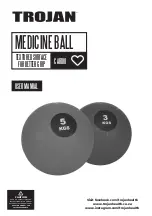
BT-780 Operation manual
48
P/N : 780-ENG-OPM-EXP-R00
Bistos Co., Ltd.
2020.03
Harmonic emissions
IEC 61000-3-2
Class A
and may be used in domestic establishments and those directly connected
to the public low-voltage power supply network that supplies buildings
used for domestic purposes, provided the following warning is heeded:
Warning:
This BT-780 is intended for use by healthcare professionals only.
This equipment/ system may cause radio interference or may disrupt the
operation of nearby equipment. It may be necessary to take mitigation
measures, such as re-orienting or relocating the BT-780 or shielding the
location.
Voltage fluctuations /
flicker emissions
IEC 61000-3-3
Complies
22.2 Recommended separation distances between portable and mobile RF communications equipment and BT-780
The BT-780 is intended for use in an electromagnetic environment in which radiated RF disturbances are controlled. The
customer or the user of the BT-780 can help prevent electromagnetic interference by maintaining a minimum distance between
portable and mobile RF communications equipment (transmitters) and the BT-780 as recommended below, according to the
maximum output power of the communications equipment.
Rated maximum
output power of
transmitter
[W]
Separation distance according to frequency of transmitter [m]
150 kHz to 80 MHz
d
=
3.5
�𝑝𝑝
80 MHz to 800 MHz
d
=
3.5
�𝑝𝑝
800 MHz to 2.5 GHz
d
=
[
7
3
]
�𝑝𝑝
0.01
0.35
0.35
0.23
0.1
1.11
1.11
0.74
1
3.5
3.5
2.34
10
11.07
11.07
7.38
100
35
35
23.24
For transmitters
rated at a maximum output power not listed above, the recommended separation distance d in meters (m)
can be estimated using the equation applicable to the frequency of the transmitter, where P is the maximum output power rating
of the transmitter in watts (W) according to the transmitter manufacturer.
NOTE 1) At 80 MHz and 800 MHz, the separation distance for the higher frequency range applies.
NOTE 2) These guidelines may not apply in all situations. Electromagnetic propagation is affected by absorption and reflection
from structures, objects and people.
22.3 Electromagnetic immunity
The BT-780 is intended for use in the electromagnetic environment specified below.
The customer or the user of the BT-780 should assure that it is used in such an environment.
Immunity test
IEC 60601 Test level
Compliance level
Electromagnetic environment -guidance
Electrostatic discharge (ESD)
IEC 61000-4-2:2009
±8 kV Contact
±15 kV air
±8 kV Contact
±15 kV air
Floors should be wood, concrete or ceramic
tile. If floors are covered with synthetic
material, the relative humidity should be at
least 30 %.
Electrical fast
transient/burst
IEC 61000-4-4:2004
±2 kV for power
supply lines
±1 kV for
input/output lines
(>3m)
±2 kV for power
supply lines
±1 kV for
input/output lines
(>3m)
Mains power quality should be that of a typical
commercial or hospital environment.
Electrical fast
transient/burst
IEC 61000-4-4:2004
±2 kV for power
supply lines
±1 kV for
input/output lines
(>3m)
±2 kV for power
supply lines
±1 kV for
input/output lines
(>3m)
Mains power quality should be that of a typical
commercial or hospital environment.
Surge
IEC 61000-4-5:2006
±1 kV differential
mode
±2 kV common mode
±1 kV differential
mode
±2 kV common mode
Mains power quality should be that of a typical
commercial or hospital environment. If the user
of the BT-780 requires continued operation
during power mains interruptions, it is
recommended that the BT-780 be powered
from an uninterruptible power supply.
Voltage dips, short
interruptions and voltage
variations on power supply
input lines
< 5 %
U
т
(> 95 % dip in
U
т)
for 0.5 cycles
40 %
U
т
(60 % dip in
U
т )
for 5 cycles
70 %
U
т
(30 % dip in
< 5 %
U
т
(> 95 % dip in
U
т)
for 0.5 cycle
40 %
U
т
(60 % dip in
U
т )
for 5 cycles
70 %
U
т
(30 % dip in
Power frequency magnetic fields should be at
levels characteristic of a typical location in a
typical commercial or hospital environment.



































